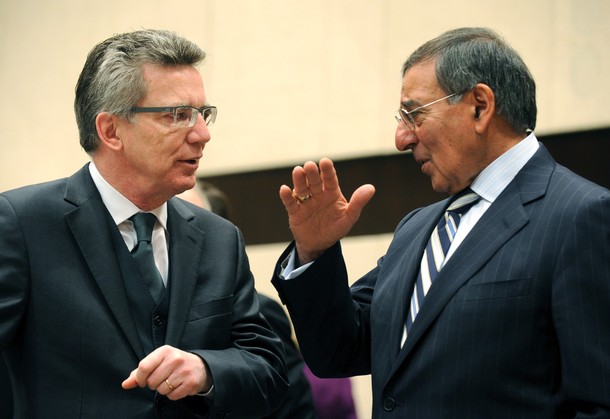
From Lolita C. Baldor, AP: Defense Secretary Leon Panetta and his German counterpart offered conflicting accounts Friday of a discussion about how many U.S. and European forces would remain in Afghanistan after the anticipated end of combat after 2014.
German Defense Minister Thomas de Maiziere told reporters Panetta had informed him at the Brussels meeting that the United States would leave between 8,000 and 10,000 troops in the war-torn country at the end of 2014.
But Panetta, speaking to reporters shortly after de Maiziere made his comments, called the remarks inaccurate.
Panetta, who will leave President Barack Obama’s Cabinet when his successor is confirmed, told reporters that he and the NATO partners instead talked about ranges of options for the post-2014 troop force. And he said the figures reflected contributions that other nations would make, in addition to the United States.
U.S. officials have yet to say publicly how many American troops will remain in Afghanistan after 2014. But Panetta said officials are planning to leave troops in all sectors of the country – north, south, east and west – as well as in Kabul. Pentagon officials have said the military has mapped out plans to carry on its mission of training and advising the Afghan forces and also leave a small counterterrorism force to battle insurgents. . . .
The Obama administration is considering a plan to maintain 352,000 Afghan troops for the next five years as part of an effort to maintain security and help convince Afghanistan that America and its allies will not abandon it once combat troops leave in 2014, senior alliance officials said Thursday. NATO officials are also widely considering that option.
Such a change, if NATO endorses it, could increase the costs to the U.S. and allies by more than $2 billion a year, at a time when most are struggling with budget cuts and fiscal woes. Last May, NATO agreed to underwrite an Afghan force of about 230,000, at a cost of about $4.1 billion a year after 2014. It costs about $6.5 billion this year to fund the current Afghan force of 352,000, and the U.S. is providing about $5.7 billion of that. (photo: Getty)
Image: getty%202%203%2012%20de%20Maiziere%20Panetta.jpg
